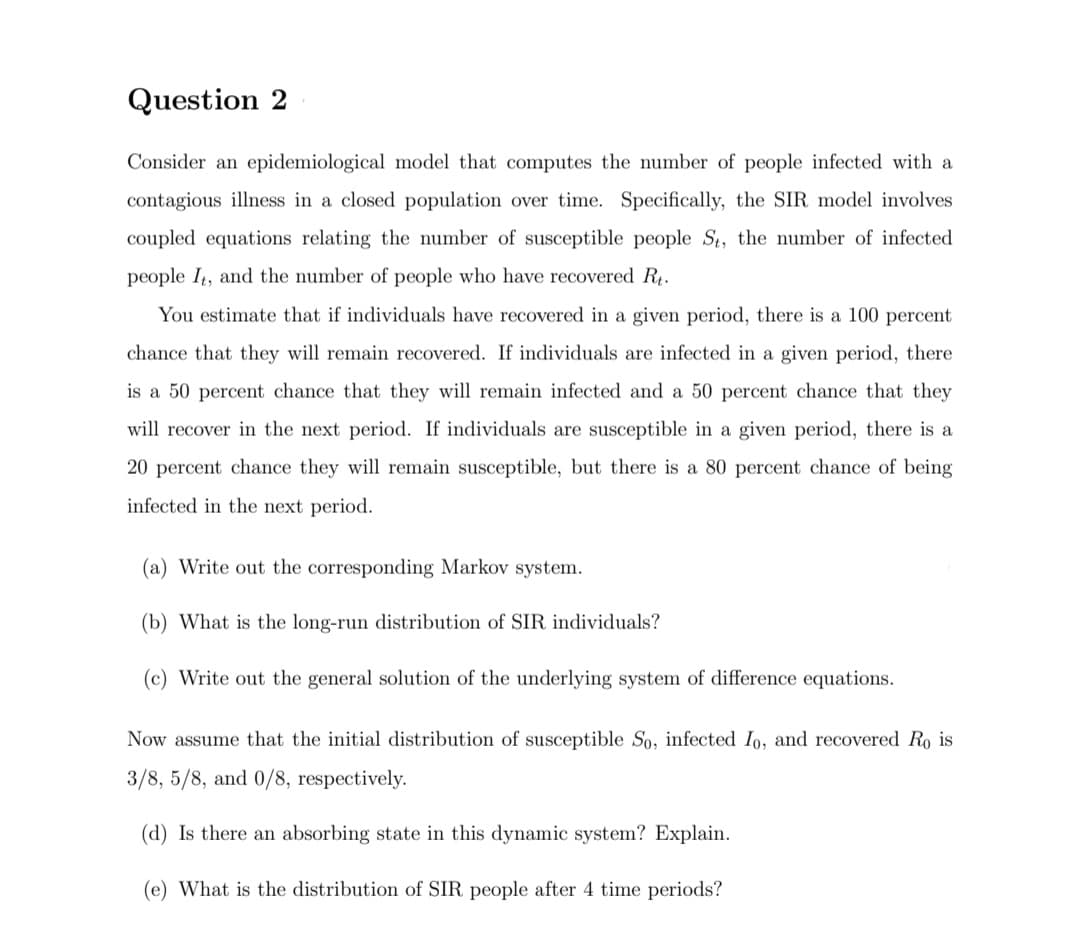Consider an epidemiological model that computes the number of people infected with a contagious illness in a closed population over time. Specifically, the SIR model involves coupled equations relating the number of susceptible people St, the number of infected people It, and the number of people who have recovered R. You estimate that if individuals have recovered in a given period, there is a 100 percent chance that they will remain recovered. If individuals are infected in a given period, there is a 50 percent chance that they will remain infected and a 50 percent chance that they will recover in the next period. If individuals are susceptible in a given period, there is a
Consider an epidemiological model that computes the number of people infected with a contagious illness in a closed population over time. Specifically, the SIR model involves coupled equations relating the number of susceptible people St, the number of infected people It, and the number of people who have recovered R. You estimate that if individuals have recovered in a given period, there is a 100 percent chance that they will remain recovered. If individuals are infected in a given period, there is a 50 percent chance that they will remain infected and a 50 percent chance that they will recover in the next period. If individuals are susceptible in a given period, there is a
Algebra & Trigonometry with Analytic Geometry
13th Edition
ISBN:9781133382119
Author:Swokowski
Publisher:Swokowski
Chapter11: Topics From Analytic Geometry
Section: Chapter Questions
Problem 47RE
Related questions
Topic Video
Question

Transcribed Image Text:Question 2
Consider an epidemiological model that computes the number of people infected with a
contagious illness in a closed population over time. Specifically, the SIR model involves
coupled equations relating the number of susceptible people St, the number of infected
people I4, and the number of people who have recovered R.
You estimate that if individuals have recovered in a given period, there is a 100 percent
chance that they will remain recovered. If individuals are infected in a given period, there
is a 50 percent chance that they will remain infected and a 50 percent chance that they
will recover in the next period. If individuals are susceptible in a given period, there is a
20 percent chance they will remain susceptible, but there is a 80 percent chance of being
infected in the next period.
(a) Write out the corresponding Markov system.
(b) What is the long-run distribution of SIR individuals?
(c) Write out the general solution of the underlying system of difference equations.
Now assume that the initial distribution of susceptible So, infected Io, and recovered Ro is
3/8, 5/8, and 0/8, respectively.
(d) Is there an absorbing state in this dynamic system? Explain.
(e) What is the distribution of SIR people after 4 time periods?
Expert Solution
This question has been solved!
Explore an expertly crafted, step-by-step solution for a thorough understanding of key concepts.
Step by step
Solved in 2 steps

Knowledge Booster
Learn more about
Need a deep-dive on the concept behind this application? Look no further. Learn more about this topic, statistics and related others by exploring similar questions and additional content below.Recommended textbooks for you

Algebra & Trigonometry with Analytic Geometry
Algebra
ISBN:
9781133382119
Author:
Swokowski
Publisher:
Cengage

Algebra & Trigonometry with Analytic Geometry
Algebra
ISBN:
9781133382119
Author:
Swokowski
Publisher:
Cengage